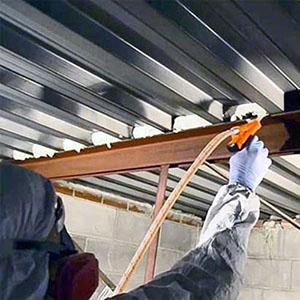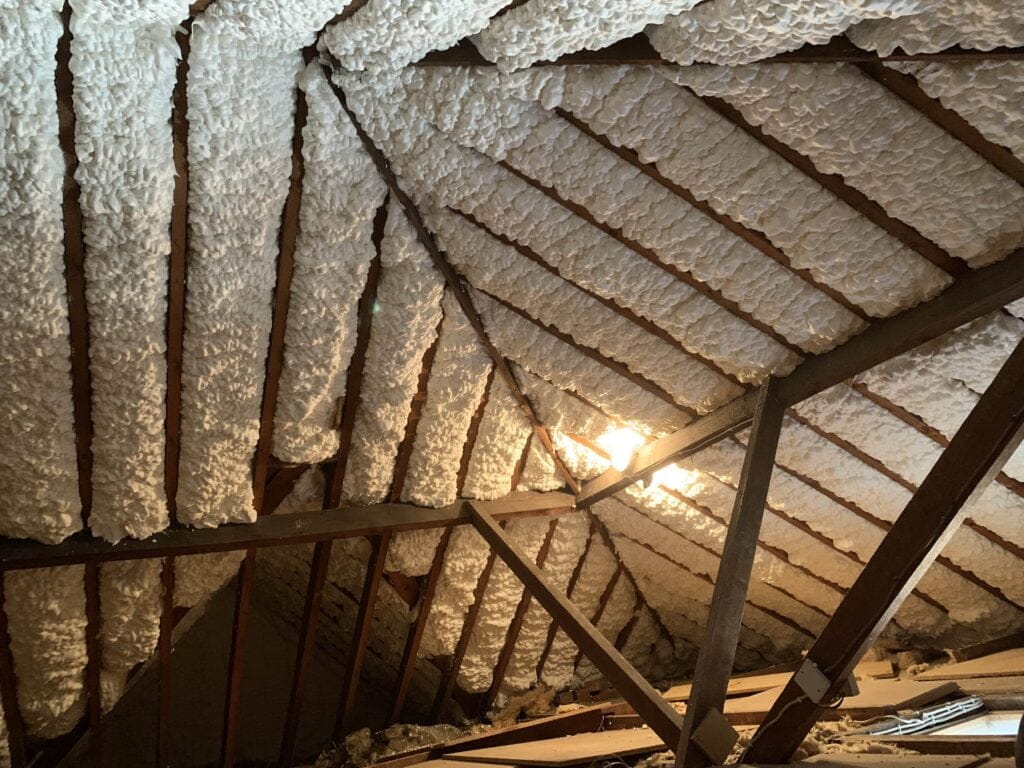The Ecological Impact of Spray Foam: Sustainability Factors To Consider
The Ecological Impact of Spray Foam: Sustainability Factors To Consider
Blog Article
Just How Spray Foam Can Improve Energy Efficiency in Any Structure
Spray foam insulation has become a crucial option for enhancing energy effectiveness throughout different building kinds. By creating an airtight seal that minimizes air leak, it effectively manages indoor climates while considerably lowering cooling and heating costs. Moreover, its impressive R-value and moisture-resistant residential or commercial properties add to long-term power cost savings and improved structure longevity. As homeowner increasingly look for lasting options, the implications of spray foam insulation prolong past plain energy cost savings. The full extent of its benefits, nonetheless, warrants a more detailed assessment of just how it can change energy management methods in both residential and industrial setups.
Recognizing Spray Foam Insulation
Spray foam insulation is significantly acknowledged for its superior thermal performance and flexibility in numerous applications. Composed largely of polyurethane, this insulation material is used as a liquid that expands upon contact, filling gaps and creating a seamless obstacle. This one-of-a-kind residential property enables spray foam to adapt irregular surface areas, making it a perfect choice for both business and residential frameworks.

Application of spray foam insulation is usually executed by qualified experts utilizing customized equipment, making sure optimum performance and safety - Spray Foam. The healing procedure is rapid, enabling for quick installation and very little disturbance. Consequently, spray foam insulation is increasingly being employed in new building and construction and retrofitting projects as a result of its capability to improve structural stability while boosting overall power effectiveness in structures
Advantages of Power Effectiveness
Power effectiveness plays a pivotal function in reducing functional expenses and decreasing ecological influence across numerous industries. By optimizing power use, services and property owners can attain considerable cost savings on utility expenses, which directly enhances monetary efficiency. Efficient energy usage indicates less dependence on fossil fuels, consequently contributing to a reduction in greenhouse gas discharges and advertising a much more lasting setting.
Moreover, energy-efficient structures frequently experience raised residential or commercial property worths. As power expenses rise and sustainability comes to be a priority for customers, residential or commercial properties with boosted power effectiveness functions are more attractive on the marketplace. This pattern encourages investment in energy-saving modern technologies, which can further drive technology and economic growth.
Along with economic and environmental advantages, power effectiveness can additionally improve the general comfort and wellness of indoor spaces. Proper insulation and reliable heating & cooling systems assist keep regular temperature levels, decreasing drafts and humidity levels, which subsequently can cause far better indoor air high quality.
Ultimately, the advantages of energy performance extend past instant savings, promoting a resilient economy, promoting environmental stewardship, and boosting the top quality of life for occupants in any structure.
Just How Spray Foam Works
Generally applied as a liquid, spray foam broadens swiftly upon call with surfaces, forming a solid barrier that properly seals fractures and spaces. This special building is due to its chemical composition, mainly including polyols and isocyanates, which respond when mixed to create a foam that fills voids and adheres to different materials, including wood, concrete, and steel.
When used, the foam broadens to numerous times its original volume, guaranteeing a tight seal that stops air leak. This process substantially reduces thermal connecting, which occurs when heat transfers via products, causing power loss. The foam's high R-value, a measure of thermal resistance, adds to boosted insulation by lessening heat transfer between the inside and outside atmospheres.
Furthermore, spray foam is resistant to dampness and insects, even more boosting its efficiency in keeping energy efficiency. Its application can be customized to different locations, consisting of attics, wall surfaces, and crawl spaces, maximizing insulation across a building. Spray Foam. Generally, the ingenious design and application technique of spray foam make it an effective remedy for enhancing energy performance in any type of structure, bring about decreased power expenses and an extra sustainable built atmosphere

Applications in Numerous Buildings
Numerous applications of spray foam insulation can be discovered throughout various structure kinds, enhancing energy efficiency and comfort. In household homes, spray foam is frequently used in attic rooms and walls to produce a smooth obstacle versus air leaks, considerably minimizing heating and cooling needs. This application is specifically beneficial in older homes, where conventional insulation might be poor.
In commercial buildings, spray foam insulation is put on roofing systems and outside wall surfaces, which aids to improve thermal performance and secure against moisture breach. Its lightweight nature makes it an optimal option for retrofitting existing frameworks without including considerable weight. In addition, spray foam can be made use of in commercial setups to insulate pipes and tank, preserving temperature control for sensitive materials.
Institutional structures, such as hospitals and schools, advantage from More Help spray foam insulation by ensuring a consistent indoor climate that sustains owner convenience and health and wellness. The adaptability of spray foam enables it to adapt to different building sizes and shapes, making it a recommended option for designers and home builders looking for efficient insulation services. Overall, spray foam insulation offers as a critical part in accomplishing energy-efficient buildings across all sectors.
Long-Term Expense Financial Savings
Spray foam insulation uses substantial lasting price financial savings for building owners and residents by lowering power usage and lowering energy bills. By providing an exceptional air seal, spray foam reduces the seepage of outdoors air, thereby boosting the thermal performance of a structure. This leads to much more efficient home heating Resources and cooling processes, which can lead to considerable reductions in power expenses over time.
Along with immediate cost savings on utility expenses, the resilience and longevity of spray foam insulation contribute to its economic advantages. Unlike typical insulation materials, which might droop, clear up, or deteriorate, spray foam preserves its effectiveness for decades, lowering the need for constant replacements or fixings. This longevity equates to decrease maintenance expenses and much less interruption for owners.
Additionally, structures equipped with spray foam insulation usually appreciate a rise in building value, making them much more attractive to possible customers or renters. As link energy performance becomes increasingly prioritized, buildings with effective insulation services stand apart out there. Ultimately, the combination of spray foam insulation not just improves convenience yet additionally stands for a strategic investment that yields significant financial benefits over the long-term.
Conclusion
In conclusion, spray foam insulation functions as a crucial element in improving energy effectiveness across diverse building types. Its ability to produce a seamless obstacle versus air leak, integrated with high R-values and moisture-resistant residential or commercial properties, considerably lowers power consumption and linked expenses. The execution of spray foam not just adds to consistent indoor temperatures yet additionally enhances building worth, highlighting its role as a sensible financial investment for both property and industrial residential or commercial properties.
Spray foam insulation has actually arised as a critical solution for boosting power effectiveness throughout different building kinds. Spray Foam. As a result, spray foam insulation is significantly being utilized in new building and construction and retrofitting jobs due to its ability to boost structural honesty while enhancing overall power efficiency in structures
In general, the cutting-edge style and application approach of spray foam make it an efficient service for boosting energy performance in any framework, leading to reduced power costs and an extra sustainable built atmosphere.
Numerous applications of spray foam insulation can be discovered throughout numerous building kinds, enhancing power performance and comfort.In conclusion, spray foam insulation offers as an important part in enhancing energy performance across varied structure types.
Report this page